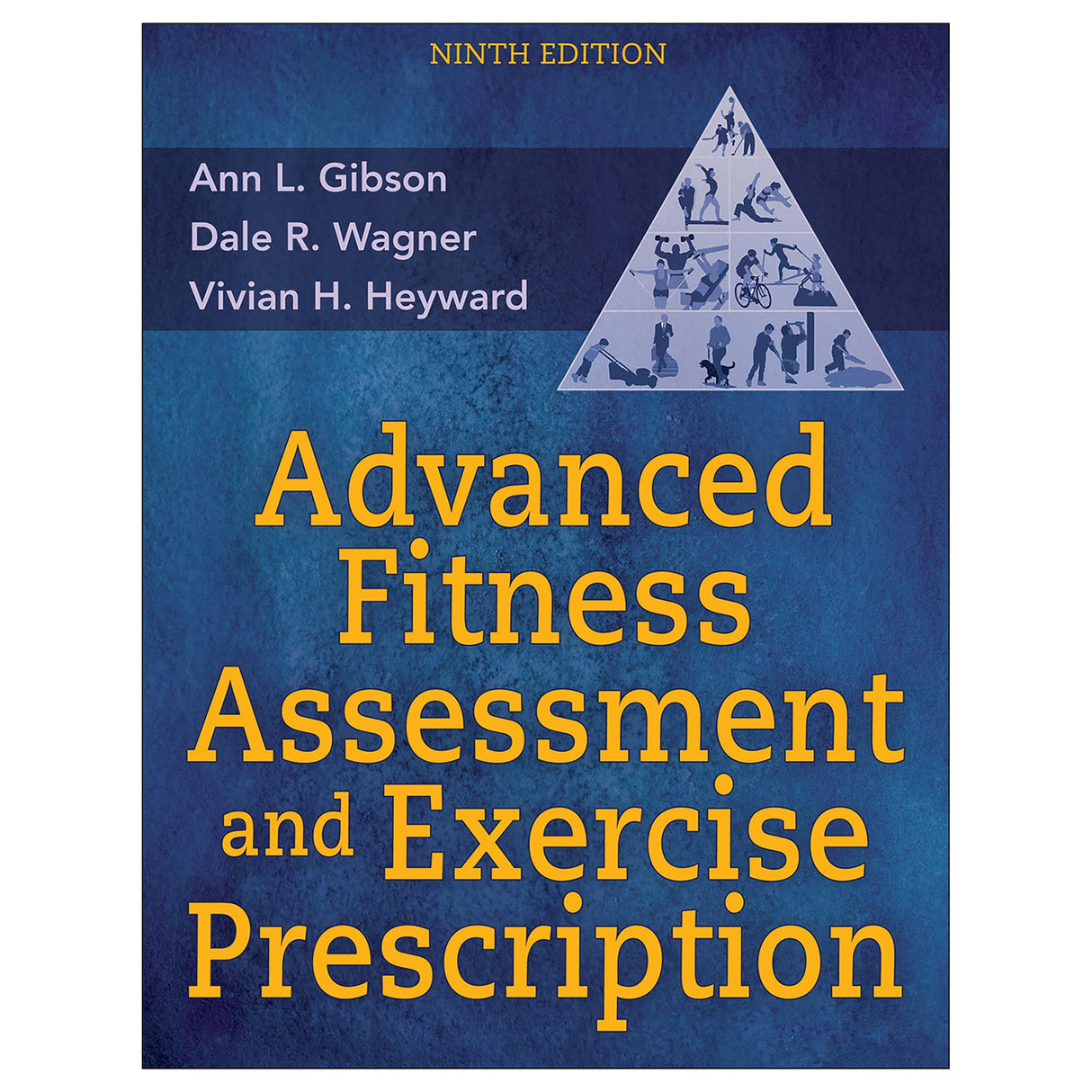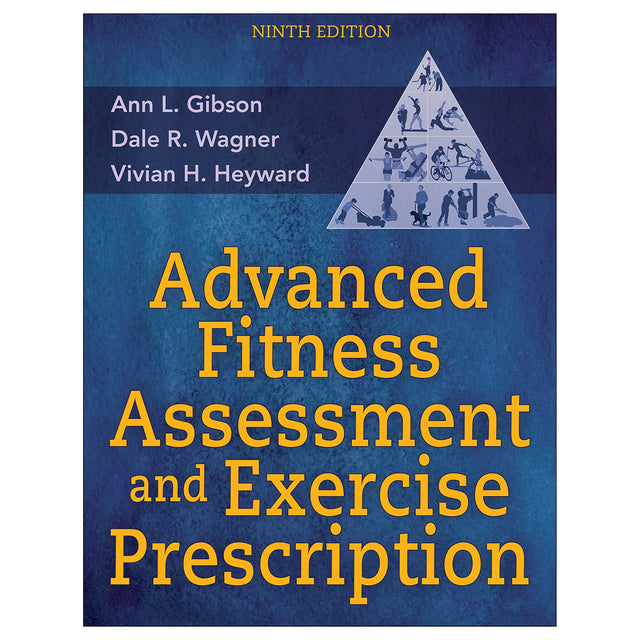Advanced Fitness Assessment and Exercise Prescription 9th Edition With HKPropel Online Video
$142.00 USD
The text reflects the most recent exercise testing and prescription guidelines from the American College of Sports Medicine (ACSM), along with physical activity recommendations from the U.S. government and American Heart Association. It highlights ACSM guidelines for physical activity and exercise testing requirements to consider before beginning exercise programs. Combining important research with practical application of testing and prescription protocols, the ninth edition also features the following:
- A new full-color interior to provide more detail and understanding of concepts through photos and figures
- New step-by-step assessment sidebars that make it easy to locate and refer to assessment procedures
- Modern guidelines for usage of current technology to test and monitor physical activity
- Demonstrations of many of the assessments and exercises, provided in 73 video clips
Finally, readers will turn research into practice by understanding how to design personalized exercise prescription, customized for each client based on individual assessment outcomes. Information on appropriate training methods and programming considerations are presented for each component of fitness.
With an unparalleled depth of coverage and clearly outlined approach, Advanced Fitness Assessment and Exercise Prescription bridges the gap between research and practice for students and exercise professionals alike who are eager to increase their knowledge and skill in assessing elements of fitness and designing individualized exercise programs.
Earn continuing education credits/units! A continuing education exam that uses this book is also available. It may be purchased separately or as part of a package that includes both the book and exam.
Note: A code for accessing online videos is included with all new print books.
Audience
Upper-undergraduate and graduate exercise science students in advanced courses dealing with physical fitness appraisal and exercise prescription; resource for health and fitness instructors, exercise physiologists, personal trainers, and strength and conditioning coaches.Physical Activity, Health, and Disease: An Overview
Cardiovascular Disease
Hypertension
Hypercholesterolemia and Dyslipidemia
Tobacco
Diabetes Mellitus
Obesity and Overweight
Metabolic Syndrome
Cancer
Musculoskeletal Diseases and Disorders
Aging
Cognitive Performance
Exercise as Medicine
Review Questions
Chapter 2. Preliminary Health Screening and Risk Classification
Preliminary Health Evaluation
Testing Procedures for Blood Pressure, Heart Rate, and Electrocardiogram
Review Questions
Chapter 3. Principles of Assessment, Prescription, and Exercise Program Adherence
Physical Fitness Testing
Basic Principles for Exercise Program Design
Exercise Program Adherence
Using Technology to Promote and Monitor Physical Activity
Review Questions
Chapter 4. Assessing Cardiorespiratory Fitness
Definition of Terms
Graded Exercise Testing: Guidelines and Procedures
Maximal Exercise Test Protocols
Submaximal Exercise Test Protocols
Field Tests for Assessing Aerobic Fitness
Exercise Testing for Children and Older Adults
Review Questions
Chapter 5. Designing Cardiorespiratory Exercise Programs
The Exercise Prescription
Aerobic Training Methods and Modes
Personalized Exercise Programs
Review Questions
Chapter 6. Assessing Muscular Fitness
Definition of Terms
Static Strength and Muscular Endurance Assessment
Dynamic Strength and Muscle Endurance Assessment
Muscular Power Assessment
Additional Considerations for Muscular Fitness Testing
Muscular Fitness Testing of Older Adults
Muscular Fitness Testing of Children
Review Questions
Chapter 7. Designing Resistance Training Programs
Types of Resistance Training
Program Variables for Dynamic Resistance Training
Developing Resistance Training Programs
Alternative Resistance Training Strategies
Other Considerations
Muscular Soreness
Review Questions
Chapter 8. Assessing Body Composition
Classification and Uses of Body Composition Measures
Body Composition Models
Reference Methods for Assessing Body Composition
Field Methods for Assessing Body Composition
Review Questions
Chapter 9. Designing Weight Management and Body Composition Programs
Obesity, Overweight, and Underweight: Definitions and Trends
Obesity: Types and Causes
Weight Management Principles and Practices
Designing Weight Management Programs: Preliminary Steps
Designing Weight Loss Programs
Designing Weight Gain Programs
Designing Programs to Improve Body Composition
Review Questions
Chapter 10. Assessing Flexibility
Basics of Flexibility
Assessment of Flexibility
Flexibility Testing of Older Adults
Review Questions
Chapter 11. Designing Programs for Flexibility and Low Back Care
Training Principles
Stretching Techniques and Methods
Designing Flexibility Programs: Exercise Prescription
Stretching for Injury Prevention and Muscle Performance
Designing Low Back Care Exercise Programs
Review Questions
Chapter 12. Assessing Balance and Designing Balance Programs
Definitions and Nature of Balance
Factors Affecting Balance and Risk of Falling
Assessment of Balance
Designing Balance Training Programs
Review Questions
Appendix A. Health and Fitness Appraisal
A.1 Physical Activity Readiness Questionnaire for Everyone (Par-Q+)
A.2 Electronic Physical Activity Readiness Medical Examination (ePARmed-X+)
A.3 Medical History Questionnaire
A.4 Risk Factors, Signs, and Symptoms of Disease
A.5 Lifestyle Evaluation
A.6 Fantastic Lifestyle Checklist
A.7 Informed Consent
A.8 Websites for Selected Professional Organizations and Institutes
Appendix B. Cardiorespiratory Assessments
B.1 Summary of Graded Exercise Test and Cardiorespiratory Field Test Protocols
B.2 OMNI Rating of Perceived Exertion Scales
B.3 Rockport Fitness Charts
B.4 Analysis of Sample Case Study in Chapter 5
Appendix C. Muscular Fitness Exercises and Norms
C.1 Standardized Testing Protocols for Digital Handheld Dynamometry
C.2 1-RM Squat and Bench Press Norms for Adults
C.3 Isometric Exercises
C.4 Dynamic Resistance Training Exercises
Appendix D. Body Composition Assessments
D.1 Prediction Equations for Residual Volume
D.2 Standardized Sites for Skinfold Measurements
D.3 Skinfold Sites for Jackson’s Generalized Skinfold Equations
D.4 Standardized Sites for Circumference Measurements
D.5 Standardized Sites for Bony Breadth Measurements
D.6 Ashwell Body Shape Chart
Appendix E. Energy Intake and Expenditure
E.1 Food Record and RDA Profile
E.2 Physical Activity Log
E.3 Gross Energy Expenditure for Select Exercises, Sports, Recreational Activities, and Activities of Daily Living
Appendix F. Flexibility and Low Back Care Exercises
F.1 Selected Flexibility Exercises
F.2 Safe Exercises and Exercises to Use With Caution
F.3 Exercises for Low Back Care
Obtaining Certification as a Fitness or exercise science professional
OMNI Rating of Perceived Exertion Scales




All ancillaries are free to adopting instructors through HKPropel.
Instructor guide. Includes a sample syllabus, a course outline, a class project, and activity and lab suggestions.
Test package. Contains 370 questions in true-false, fill-in-the-blank, essay and short-answer, and multiple-choice formats. The files may be downloaded for integration with a learning management system or printed for use as paper-based tests. Instructors may also create their own customized quizzes or tests from the test bank questions to assign to students directly through HKPropel. Multiple-choice and true-false questions are automatically graded, and instructors can review student scores in the platform.
Chapter quizzes. Contains ready-made quizzes (9-10 questions each) to assess student comprehension of the most important concepts in each chapter. Each quiz may be downloaded or assigned to students directly through HKPropel. The chapter assessments are automatically graded, and instructors can review student scores in the platform.
Presentation package. Features more than 364 PowerPoint slides of text, artwork, and tables from the book that can be used for class discussion and presentation. The slides in the presentation package can be used directly within PowerPoint or printed to make handouts for students. Instructors can easily add, modify, and rearrange the order of the slides.
Image bank. Includes most of the figures, content photos, and tables from the text, sorted by chapter. These can be used in developing a customized presentation based on specific course requirements.
Instructors also receive access to all student materials in HKPropel. For Advanced Fitness Assessment and Exercise Prescription, this includes 73 video clips that demonstrate how to perform many of the assessments and exercises covered in the book.





